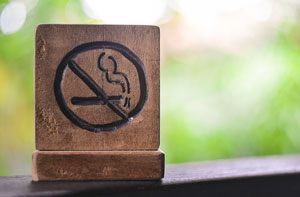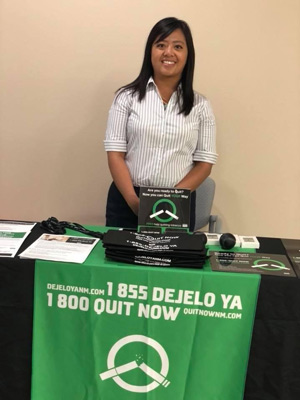Nicotine Use Prevention and Control (NUPAC) Program
- Need: To foster relationships with American Indian people in New Mexico to determine culturally appropriate practices in reducing nicotine addiction.
- Intervention: NUPAC provides outreach, community programs, and cessation services.
- Results: In fiscal year 2023, 1,333 QUIT NOW and DEJELO YA quit line enrollees stopped using tobacco.
Description
 According to a
2019 New Mexico Department of Health report, about
31,000 American Indian adults and 4,600 youth in New
Mexico smoke cigarettes. The Nicotine Use Prevention and
Control (NUPAC)
Program provides services and activities to schools,
organizations, and communities to reduce non-ceremonial
use of tobacco.
According to a
2019 New Mexico Department of Health report, about
31,000 American Indian adults and 4,600 youth in New
Mexico smoke cigarettes. The Nicotine Use Prevention and
Control (NUPAC)
Program provides services and activities to schools,
organizations, and communities to reduce non-ceremonial
use of tobacco.
NUPAC has two funding sources: a CDC cooperative agreement and money from the 1998 Master Settlement Agreement.
Services offered

NUPAC activities include:
- Cessation services
- Community programs
- Outreach and education
- Initiatives addressing health disparities
- Interactive trainings
- School tobacco policies
NUPAC contracts with a wellness company to provide tobacco cessation services, including health professional training. The Health Systems Change Training and Outreach Program provides consultation, technical assistance, training, and outreach curriculum.
Results
Through NUPAC, the percentage of people who made an attempt to quit using tobacco went from 47% of current users in 2014 to 54% in 2018. In fiscal year 2020, 1,938 QUIT NOW and DEJELO YA quit line enrollees stopped using tobacco, and over 4,520 tobacco users made progress on their path to quitting (such as smoking fewer cigarettes each day). In fiscal year 2023, 1,333 QUIT NOW and DEJELO YA quit line enrollees stopped using tobacco.
With support and technical assistance from NUPAC, 49 of the 50 Navajo Nation Chapters (local governments) in the state passed smoke-free Tribal Resolutions.
To learn more about NUPAC's help in developing a culturally grounded Spanish-language media campaign for the DEJELO YA quit line:
Dilley, J.A., Otero, M., Padilla, J.L., Costello, H., Turietta, T., & Jácquez, B. (2020). DEJELO YA Media Campaign Connects Spanish-Speaking Communities to Effective Support for Quitting Tobacco. Health Promotion Practice, 21, 89S-97S. Article Abstract
Challenges
New Mexico is primarily a rural/frontier state, so providing services to its rural populations is always a consideration when planning and implementing tobacco control services statewide. Large distances between communities and limited services such as transportation to get to the services are continuing barriers that need to be addressed in these rural communities.
Funding continues to be a challenge.
Replication
Building a partnership based on trust is key, since American Indian populations have historical trauma of being mistreated and oppressed by government agencies. NUPAC uses an anti-oppression framework to educate its staff on oppression and its effect on access to services.
It also takes time to form partnerships with stakeholders, since they have competing priorities.
Contact Information
Esther Hoang, Program ManagerNew Mexico Department of Health
NUPAC
Esther.Hoang@doh.nm.gov
Topics
American Indian or Alaska Native
Tobacco use
States served
New Mexico
Date added
October 8, 2019
Date updated or reviewed
January 29, 2024
Suggested citation: Rural Health Information Hub, 2024. Nicotine Use Prevention and Control (NUPAC) Program [online]. Rural Health Information Hub. Available at: https://www.ruralhealthinfo.org/project-examples/1069 [Accessed 15 December 2024]
Please contact the models and innovations contact directly for the most complete and current information about this program. Summaries of models and innovations are provided by RHIhub for your convenience. The programs described are not endorsed by RHIhub or by the Federal Office of Rural Health Policy. Each rural community should consider whether a particular project or approach is a good match for their community’s needs and capacity. While it is sometimes possible to adapt program components to match your resources, keep in mind that changes to the program design may impact results.
